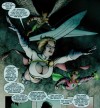
|
Has Blackest Night been a smash hit for DC comics? Commercially, there’s no question, it’s been a huge success, building on top of the growing readership of Geoff Johns’ Green Lantern run, and trying to use that to build interest in other DC titles. To put it cynically, that’s basically the point of comics “events”: Get people to pick up some books they wouldn’t otherwise read, and hope a few of them stick around to keep reading them. While I think they could have executed the crossover aspect better (I’ve griped that the free ring promotion was undercut by the issues promoted by the rings didn’t make much effort to explain to new readers what was going on or why we should care), overall DC certainly deserves credit for their marketing of the event.
But is the story any good?
To compare it to other recent events, it doesn’t have a high bar to cross. Of DC’s recent events, Identity Crisis was a collection of continuity navel-gazing mixed with a vile rewriting of some characters’ actions and motivations; Infinite Crisis had a plot that made no sense whatsoever and which introduced one of the least-welcome villains in recent years in Superboy Prime; and Final Crisis was no more comprehensible while additionally being pretentious and focusing on a lot of third- and fourth-string characters. Marvel’s events have been better-executed, although the stories haven’t been much good either; Civil War mucked up characters’ motivations in unbelievable ways, and Secret Invasion (Marvel’s equivalent of DC’s awful late-80s event Millennium) had an unbelievable plot.
By contrast, Blackest Night is fairly comprehensible, and rather than working with long-forgotten details of continuity, it grows out of Geoff Johns’ current storylines in Green Lantern, in which he’s introduced a full spectrum of magic-ring-wielding organizations, each tied to a different emotion. While perhaps a bit cute, Johns has established that he’s more interested in moving his story forward than in making everything line up perfectly with all the GL history from the past, and these days that seems almost novel.
As for the story itself, here’s how it’s developed so far:
- Blackest Night #0: In this Free Comic Book Day giveaway, Green Lantern (the Hal Jordan version) and Flash (the Barry Allen version) catch up on recent developments in the DC universe, especially characters who have recently died, including Batman, whose grave they’re visiting during their reminiscence. After they leave, a minor GL villain Black Hand shows up to claim Batman’s skull (a good trick, since the last pages of Final Crisis showed that Wayne wasn’t actually dead, even though there was a body, but I suspect Johns is ignoring this detail) and state that by his hand the dead shall rise. Green Lantern #43 goes into detail about the Hand’s background.
- Blackest Night #1: From the giant black lantern in space sector 666, black power rings emerge and fly across the universe, on the same day that the Earth remembers all his fallen heroes. Meanwhile, a “war of light” erupts among the various lantern corps. The black rings resurrect many of Earth’s dead heroes, and several of them kill and recruit Hawkman and Hawkgirl. In Green Lantern #44, Flash and GL fight the undead Martian Manhunter, learning that the zombie-like creatures cannot be killed.
- Blackest Night #2: Undead Aquaman kills Aqualad, and the black ring takes over The Spectre. The black rings are unable to recruit Dove, however. In Green Lantern #45, the black lanterns start attacking other ring wielders.
- Blackest Night #3: The black lantern Justice League fight Flash, GL and the Atom, the tribe of indigo lanterns show up to save them, revealing that a Green Lantern’s ring combined with one of the other colors can sever the black rings’ connections to their hosts. GL is spirited away by the indigo tribe, and the black rings take over Firestorm and claim the villains whose corpses are (oddly) buried below the Justice League’s headquarters.
- Blackest Night #4: The world’s heroes fight a losing battle against the black lanterns as the black power levels reach 100%. The main black lantern is transported to Earth, and we learn that the entity behind the rings is a minor villain named Nekron. Over in Green Lantern, GL and the indigo lanterns recruit different colored lanterns to fight the black lanterns.
- Blackest Night #5: The Justice League shows up to help Flash, Atom and Mera fight the black lanterns, and GL’s rainbow corps arrives to fight Nekron, but they don’t have the power to shut down Nekron’s battery. The black rings execute and recruit all the heroes who have died and been resurrected, such as Superman and Wonder Woman.
- Blackest Night #6: In the latest issue, Flash’s quick thinking saves him and GL from the same fate as the other resurrected heroes. One of the Guardians of the Universe, Ganthet, uses his power to cause the various colored rings to generate new rings and recruit various candidates from Earth, to boost their power against Nekron.
There are still 2 issues to go – plus whatever Johns does over in Green Lantern – and the story feels fairly convoluted. It’s essentially been a running battle between the living and the dead, with the living having little hope of winning unless the lanterns can pull together and somehow destroy Nekron’s battery. The story seems to have taken place over only a couple of days (certainly no one’s caught any sleep or even had a shower during the series), which makes it rather brief for a whole war. But that’s comic books for you.
The motivations in the story are reasonably sensical for superhero comics: Nekron is an avatar of death who wants to eradicate all life to return the universe to a peaceful state (oddly, this detail is explained in an issue of Adventure Comics rather than in the main series). Why he needs to work through Black Hand to do this is not explained, though. The main emotional tension in the story is in the seven different ring-wielders trying to work together, especially since the red and orange lanterns aren’t exactly joiners. But it’s not exactly deep stuff.
And that’s really the series’ flaw: Even though it’s not the usual cynical crossover series, it’s basically just a big slugfest, with desperate situations and some witty dialogue thrown in. Johns has certainly done much better character-oriented drama in Green Lantern and I wonder if Blackest Night would have worked better had it been constrained to just the GL titles rather than roping in every character in the DC universe. The cast of characters has gotten so large that it’s difficult to care much about anyone, because there’s not much room for proper development. (Obviously, this ended up being the case in the grand-daddy of all crossover series, Crisis on Infinite Earths, but back then we didn’t really know what the drawback of such sprawling stories would be. Marv Wolfman, the writer of that crisis, took some interesting approaches to make the story more personal despite its huge scale, too, and Johns only occasionally personalizes things in Blackest Night.)
Could Blackest Night be better? Certainly, although it would probably be a fairly different story. Is it better than other recent DC events? That’s also true. Event comics always have a tendency to go for the lowest common denominator (although Marvel’s tried to avoid that at the cost of making uncomfortable and sometimes implausible changes to their characters and settings), so seeing one rise above that low level is interesting enough. Still, unless Johns has a big surprise up his sleeve, Blackest Night looks like it’s going to end up as just one more sprawling fight, a very nicely drawn one by Ivan Reis and his cast of inkers, but still, not a truly memorable series.
Check back in two months and we’ll see how things turned out.
|





































